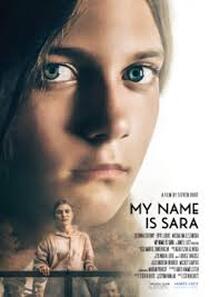 Moving forward in time from my last article, which showcased a short film set in the Pale of Settlement in the mid-19th century, this one is about a full-length feature where the action takes place on the Polish/Ukrainian border during World War II. My Name is Sara is the story of a 13-year-old Polish Jew who flees from the Nazis to a small rural settlement and finds refuge – although a cold and insecure one - with a Ukrainian farming family. The film is an American/Polish co-production directed by Steven Oritt. It was filmed on location in Podlasie, Poland, strongly evoking a sense of the nature of the area, the sweeping, rural landscapes, the forests and country towns as they would have looked in the middle of the last century. Filming locations included Tykocin, Czerlonka, Białystok and Puchły. At her parents’ insistence, Sara and her brother escape from the ghetto in Korzec, Poland, close to the Ukrainian border, before it is liquidated in 1942. They flee in the middle of the night through miles of forest, across a river where Sara would have drowned had her brother not been there to save her. They eventually make their way to the home of a Ukrainian woman whom Sara’s parents had paid to take in and care for their two oldest children. They stay for some days, but sense that the woman is nervous, and that they should move on. Sara makes the decision to continue alone. Walking on towards Ukraine, Sara creates a false identity and life story for herself, using the name of a Catholic friend. Luckily, she is well versed in Catholic prayers and rituals, knowledge that without doubt saves her life on several occasions. Determined above all else to guard the secret of her true identity, she finds work on a small farm owned by a Ukrainian couple, and soon discovers that they harbour secrets of their own. The role of Sara is powerfully played by a young actress by the name of Zuzanna Surowy. There are moments of horror and sacrifice, as one would expect from a film depicting events that took place during the Holocaust, but this is not a depressing film. It is beautifully shot, to the extent that many of the scenes look almost like paintings. The film was released in the US in 2019, and in the UK, where it was oddly renamed The Occupation, in 2020. My name is Sara is based on the true story of Sara Góralnik, who was born in Korzec on May 10 1930. She was the second of four children, the only girl, and the only one of her family to survive the Holocaust. Her hometown was occupied by the Soviet Union in 1939, then by the Nazis in 1941. When Sara was just 12 years old, her family received word that all Jews living in the ghetto were to be murdered. “You and your brother will run away,” her mother said, according to Sara’s testimony to the Shoah Foundation in 2012. “And, I said ‘No. If they are going to kill you, let them kill me. I’m not going.’” Sarah’s son Mickey Shapiro, who was born in a displaced persons’ camp in Germany in 1947, is one of the film’s executive producers. “I was curious and I knew bits and pieces of the story, but I didn’t get all of it and I wasn’t going to push her to tell the story,” says Mickey. “My mother never talked about it. She never really verbalised what happened.” Sara began to talk a little more as she got older, then after a visit to the US Holocaust Memorial Museum in Washington DC with her grandchildren, she began to share her story in detail. “This is a strong movie about a strong woman who survives. It needs to be seen,” Mickey says. Sara died in 2018.
0 Comments
Leave a Reply. |
Keeping stories aliveThis blog aims to discuss historical events relating to the Jewish communities of Ukraine, and of Eastern Europe more widely. As a storyteller, I hope to keep alive stories of the past and remember those who told or experienced them. Like so many others, I am deeply troubled by the war in Ukraine and for the foreseeable future, most articles published here will focus on the war, with an emphasis on parallels with other tumultuous periods in Ukraine's tragic history. Archives
March 2024
Categories
All
|
 RSS Feed
RSS Feed
